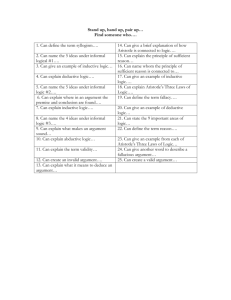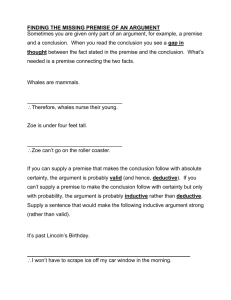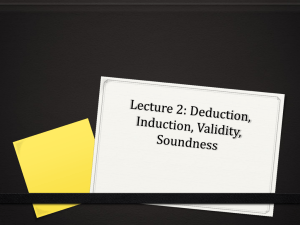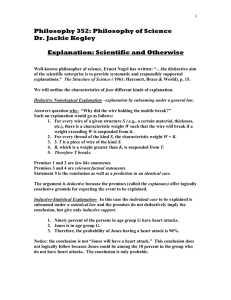Hurley Ch. 1 Answers
advertisement
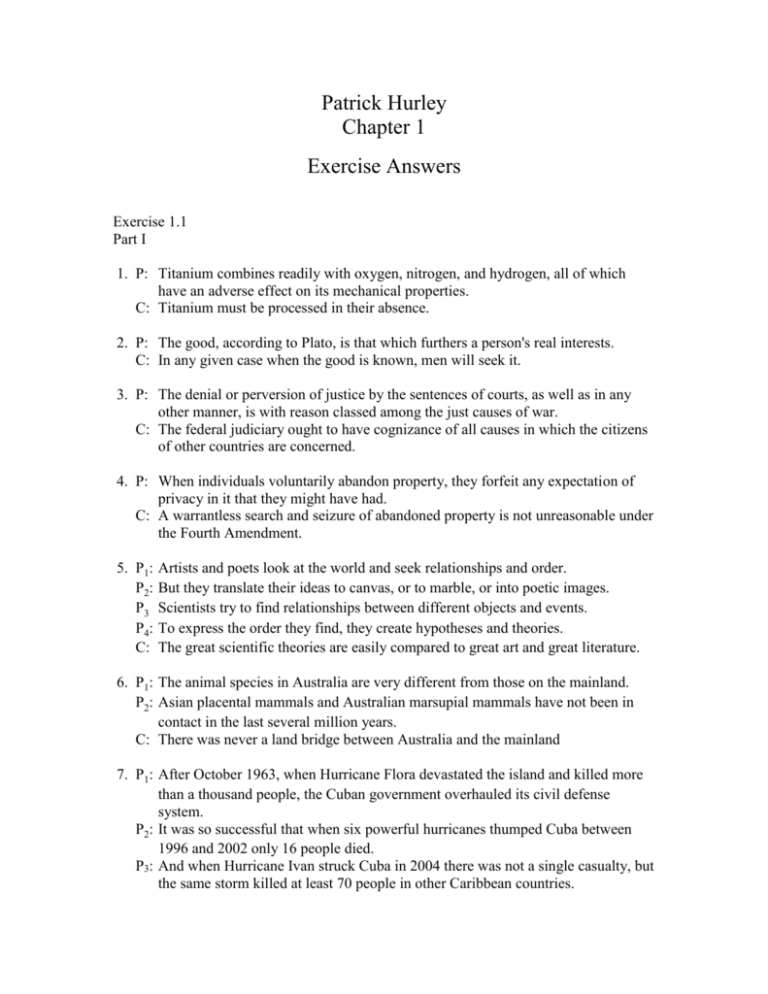
Patrick Hurley Chapter 1 Exercise Answers Exercise 1.1 Part I 1. P: Titanium combines readily with oxygen, nitrogen, and hydrogen, all of which have an adverse effect on its mechanical properties. C: Titanium must be processed in their absence. 2. P: The good, according to Plato, is that which furthers a person's real interests. C: In any given case when the good is known, men will seek it. 3. P: The denial or perversion of justice by the sentences of courts, as well as in any other manner, is with reason classed among the just causes of war. C: The federal judiciary ought to have cognizance of all causes in which the citizens of other countries are concerned. 4. P: When individuals voluntarily abandon property, they forfeit any expectation of privacy in it that they might have had. C: A warrantless search and seizure of abandoned property is not unreasonable under the Fourth Amendment. 5. P1: P2: P3 P4: C: Artists and poets look at the world and seek relationships and order. But they translate their ideas to canvas, or to marble, or into poetic images. Scientists try to find relationships between different objects and events. To express the order they find, they create hypotheses and theories. The great scientific theories are easily compared to great art and great literature. 6. P1: The animal species in Australia are very different from those on the mainland. P2: Asian placental mammals and Australian marsupial mammals have not been in contact in the last several million years. C: There was never a land bridge between Australia and the mainland 7. P1: After October 1963, when Hurricane Flora devastated the island and killed more than a thousand people, the Cuban government overhauled its civil defense system. P2: It was so successful that when six powerful hurricanes thumped Cuba between 1996 and 2002 only 16 people died. P3: And when Hurricane Ivan struck Cuba in 2004 there was not a single casualty, but the same storm killed at least 70 people in other Caribbean countries. C: Cuba’s record on disaster prevention is impressive. 8. P1: The classroom teacher is crucial to the development and academic success of the average student. P2: Administrators simply are ancillary to this effort. C: Classroom teachers ought to be paid at least the equivalent of administrators at all levels, including the superintendent. 9. P1: An agreement cannot bind unless both parties to the agreement know what they are doing and freely choose to do it. C: The seller who intends to enter a contract with a customer has a duty to disclose exactly what the customer is buying and what the terms of the sale are. 10. P1: Punishment, when speedy and specific, may suppress undesirable behavior. P2: Punishment cannot teach or encourage desirable alternatives. C: It is crucial to use positive techniques to model and reinforce appropriate behavior that the person can use in place of the unacceptable response that has to be suppressed. 11. P1: High profits are the signal that consumers want more of the output of the industry. P2: High profits provide the incentive for firms to to expand output and for more firms to enter the industry in the long run. P3: For a firm of above average efficiency, profits represent the reward for greater efficiency. C: Profit serves a very crucial function in a free enterprise economy, such as our own. 12. P1: My cat regularly used to close and lock the door to my neighbor's doghouse, trapping their sleeping Doberman inside. P2: Try telling a cat what to do, or putting a leash on him--he'll glare at you and say, "I don't think so. You should have gotten a dog." C: Cats can think circles around dogs. 13. P1: Private property helps people define themselves. P2: Private property frees people from mundane cares of daily subsistence. P3: Private property is finite. C: No individual should accumulate so much property that others are prevented from accumulating the necessities of life. 14. P1: To every existing thing God wills some good. P2: To love any thing is nothing else than to will good to that thing. C: It is manifest that God loves everything that exists. 15. P1: The average working man can support no more than two children. P2: The average working woman can take care of no more than two children in decent fashion. C: Women of the working class, especially wage workers, should not have more than two children at most. 16. P1: The nations of planet earth have acquired nuclear weapons with an explosive power equal to more than a million Hiroshima bombs. P2: Studies suggest that explosion of only half these weapons would produce enough soot, smoke, and dust to blanket the Earth, block out the sun, and bring on a nuclear winter that would threaten the survival of the human race. C: Radioactive fallout isn't the only concern in the aftermath of nuclear explosions. 17. P1: An ant releases a chemical when it dies, and its fellows carry it away to the compost heap. P2: A healthy ant painted with the death chemical will be dragged to the funeral heap again and again. C: Apparently the communication is highly effective. 18. P: Every art and every inquiry, and similarly every action and pursuit, is thought to aim at some good. C: The good has been rightly declared to be that at which all things aim. 19. P1: Antipoverty programs provide jobs for middle-class professionals in social work, penology and public health. P2: Such workers' future advancement is tied to the continued growth of bureaucracies dependent on the existence of poverty. C: Poverty offers numerous benefits to the non-poor. 20. P1: Corn is an annual crop. P2: Butchers meat is a crop which requires four or five years to grow. P3: An acre of land will produce a much smaller quantity of the one species of food (meat) than the other. C: The inferiority of the quantity (of meat) must be compensated by the superiority of the price. 21. P1: Loan oft loses both itself and friend. P2: Borrowing dulls the edge of husbandry. C: Neither a borrower nor lender be. 22. P1: Take the nurse who alleges that physicians enrich themselves in her hospital through unnecessary surgery. P2: Take the engineer who discloses safety defects in the braking systems of a fleet of new rapid-transit vehicles. P3: Take the Defense Department official who alerts Congress to military graft and overspending. P4: All know that they pose a threat to those whom they denounce and that their own careers may be at risk. C: The stakes in whistleblowing are high. 23. P1: If a piece of information is not "job relevant," then the employer is not entitled qua employer to know it. P2: Sexual practices, political beliefs, associational activities, etc., are not part of the description of most jobs P3: They do not directly affect one's job performance. C: They are not legitimate information for an employer to know in the determination of the hiring of a job applicant. 24. P1: One of the most noticeable effects of a dark tan is premature aging of the skin. P2: The sun also contributes to certain types of cataracts, and, what is most worrisome, it plays a role in skin cancer. C: Too much sun can lead to health problems. 25. P1: It is generally accepted that by constantly swimming with its mouth open, the shark is simply avoiding suffocation. P2: This assures a continuous flow of oxygen-laden water into their mouths, over their gills, and out through the gill slits. C: Contrary to the tales of some scuba divers, the toothsome, gaping grin on the mouth of an approaching shark is not necessarily anticipatory. 26. P: If you place a piece of Polaroid (for example, one lens of a pair of Polaroid sunglasses) in front of your eye and rotate it as you look at the sky on a clear day, you will notice a change in light intensity with the orientation of the Polaroid. C: Light coming from the sky is partially polarized. 27. P1: The secondary light [from the moon] does not inherently belong to the moon, and is not received from any star or from the sun. P2: In the whole universe there is no other body left but the earth. C: The lunar body (or any other dark and sunless orb) is illuminated by the earth. 28. P1: Anyone familiar with our prison system knows that there are some inmates who behave little better than brute beasts. P2: If the death penalty had been truly effective as a deterrent, such prisoners would long ago have vanished. C: The very fact that these prisoners exist is a telling argument against the efficacy of capital punishment as a deterrent. 29. P1: REM (rapid eye movement) sleep studies conducted on adults indicate that REM pressure increases with deprivation. P2: This would not occur if REM sleep and dreaming were unimportant. C: REM sleep and dreaming are necessary in the adult. 30. P1: World government means one central authority, a permanent standing world police force, and clearly defined conditions under which this force will go into action. P2: A balance of power system has many sovereign authorities, each controlling its own army, combining only when they feel like it to control aggression. C: World government and the balance of power are in many ways opposites. Part II. 1. College sports are as much driven by money as professional sports. 2. The creation of a multilingual society is contrary to the best interests of all of us. 3. The competitive aspect of team sports is having a negative impact on the health and fitness of our children. 4. Business majors are robbing themselves of the true purpose of collegiate academics, a sacrifice that outweighs the future salary checks. 5. The sale and purchase of recreational drugs should be legalized. 6. Congress should not cut the National Institutes of Health budget. 7. The religious intolerance of television preachers must not be tolerated. 8. Patients should not be offered elective Cesarean section. 9. Parents who truly love their children allow them to fail once in a while. 10. Protecting the environment requires that we limit population growth. Part III 1. Logic: The organized body of knowledge, or science, that evaluates arguments. 2. Argument: A group of statements one or more of which (the premises) are claimed to provide support for, or reasons to believe, one of the others (the conclusion). 3. Statement: A sentence that is either true or false. 4. Premise: A statement in an argument that sets forth evidence or reasons. 5. Conclusion: The statement in an argument that the premises are claimed to support or imply. 6. Conclusion indicator: A word that provides a clue in identifying the conclusion. 7. Premise indicator: A word that provides a clue in identifying the premises. 8. Inference: The reasoning process used to produce an argument. 9. Proposition: The information content of a statement. 10. Truth value: The attribute by which a statement is either true or false. Part IV 1. 2. 3. 4. 5. True False False False True 6. 7. 8. 9. 10. False True True True True Exercise 1.2 Part I 1. Nonargument (explanation) 2. Nonargument; conditional statement 3. Argument (conclusion: Freedom of the press is the most important of our constitutionally guaranteed freedoms.) 4. Nonargument (illustration) 5. Nonargument (piece of advice) 6. Argument (conclusion: Mosquito bites are not always the harmless little irritations most of us take them to be.) 7. Argument (conclusion: If stem-cell research is restricted, then people will die prematurely.) 8. Argument (conclusion: Fiction provides us with the opportunity to ponder how people react in uncommon situations, and to deduce moral lessons, psychological principles, and philosophical insights from their behavior.) 9. Nonargument (statement of belief) 10. Nonargument (report) 11. Argument (conclusion: Any interest of the state in protecting the woman from an inherently hazardous procedure, except when it would be equally dangerous for her to forgo it, has largely disappeared. 12. Nonargument (expository passage) 13. Nonargument (opinion) 14. Nonargument (report of an argument) 15. Argument (conclusion: Economics is of practical value in business.) 16. Nonargument (piece of advice) 17. Nonargument (loosely associated statements) 18. This passage could be interpreted as either an argument or an explanation (or both). If it is interpreted as an argument, the conclusion is: Most business organizations include a credit department which must reach a decision on the credit worthiness of each prospective customer. 19. Argument (conclusion: For organisms at the sea surface, sinking into deep water usually means death.) 20. Nonargument (temporal meaning of "since"; "hence" indicates an explanation.) 21. Argument (conclusion: Dachshunds are ideal dogs for small children.) 22. Argument (conclusion: Atoms can combine to form molecules, whose properties are generally very different from those of the constituent atoms.) 23. Argument (conclusion: The coarsest type of humor is the practical joke.) 24. Nonargument (conditional statement) 25. Nonargument (explanation) 26. Argument (conclusion: Words are slippery customers.) 27. Nonargument (report) 28. Argument (conclusion: A person never becomes truly self-reliant.) 29. Nonargument (opinion) 30. Nonargument (illustration) 31. This passage could be both an argument and an explanation (conclusion: In areas where rats are a problem, it is very difficult to exterminate them with bait poison.) 32. Both an argument and an explanation (conclusion: Men are less likely to develop osteoporosis until later in life than women and seldom suffer as severely.) 33. Argument (conclusion: Newspapers, radio, and television are essential for a democracy.) 34. Nonargument (loosely associated statements) 35. Argument (conclusion: The plane mirror remains an important element in the modern arsenal of sophisticated optical devices.) Part II 1. Nonargument 2. Argument (conclusion: The emphasis on computers in elementary schools is harmful.) 3. This passage is probably best considered a nonargument, but it could be rephrased to form an argument. (Possible conclusion: Something is wrong with our approach to education.) 4. Nonargument 5. Argument (conclusion: In opposing obligatory prayer in the public schools I am actually serving my God.) 6. Argument (conclusion: Religious fundamentalists are preventing our children from learning science. Or We must eliminate the influence of religious fundamentalism in our public schools.) 7. Argument (conclusion: The poor quality of parenting and the lack in continuity of adult care provided to many U.S. children contribute to a passivity and a sense of helplessness that hobbles individuals for the remainder of their lives.) 8. Argument (conclusion: Global capitalism is attended by serious inequities.) 9. Argument (main conclusion: The suggestion by socio-biologists that stepparent child abuse has evolutionary advantages is superficial. Intermediate conclusion: there are plenty of loving and generous stepparents around.) 10. Nonargument Part IV 1. Argument from example: An argument that purports to prove something by giving one or more examples of it. 2. Conditional statement: An "if ... then ..." statement 3. Antecedent: The component of a conditional statement that immediately follows the word "if." 4. Consequent: The component of a conditional statement that immediately follows the word "then"; the component of a conditional statement that is not the antecedent 5. Sufficient condition: The condition represented by the antecedent of a conditional statement 6. Necessary condition: The condition represented by the consequent of a conditional statement 7. Explanation: A statement or group of statements intended to shed light on some event 8. Explanandum: The component of an explanation that indicates the event or phenomenon to be explained 9. Explanans: The component of an explanation that ex plains the event indicated by the explanandum 10. Illustration: A kind of nonargument composed of statements intended to show what something means or how something is done. 11. Expository passage: A kind of Nonargument consisting of a topic sentence and one or more other sentences that expand or elaborate on the topic sentence. Part V 1. True 2. False 6. True 7. True 3. False 4. True 5. True 8. True 9. True 10. True Part VI 1. Sufficient: If something is a tiger, then it is an animal. 2. Necessary: If something is not an animal, then it is not a tiger. Or: If something is a tiger, then it is an animal. 3. Sufficient: If a person drinks water, then he will quench his thirst. 4. Necessary: If a person has no racquet, then he/she cannot play tennis. Or: If a person plays tennis, then he/she has a racquet. 5. Necessary: If a person does not pull the cork, then he/she cannot drink a bottle of expensive wine. Or: If a person drinks a bottle of expensive wine, then he/she has pulled the cork. 6. Sufficient: If someone steps on a cat’s tail, then the cat will yowl. 7. Sufficient: If leaves burn, then smoke is produced. 8. Necessary: If a person does not pay attention, then he/she will not understand a lecture. Or: If a person understands a lecture, then he/she pays attention. 9. Sufficient: If a person takes a swim in the North Sea, then he/she will cool off. 10. Necessary: If a person does not open the door, then he/she cannot cross the threshold. Or: If a person crosses the threshold, then he/she has opened the door. Exercise 1.3 Part I 1. Deductive (argument based on mathematics; also, the conclusion follows necessarily from the premises.) 2. Inductive (argument based on signs) 3. Inductive (prediction; also, there is an inductive indicator word and the conclusion follows only probably from the premise.) 4. Deductive (categorical syllogism; also, the conclusion follows necessarily from the premises.) 5. Inductive (generalization) 6. Deductive (the conclusion follows necessarily from the premise) 7. Inductive (causal inference; also, the conclusion follows only probably from the premise.) 8. Deductive (the conclusion follows necessarily from the premises.) 9. Inductive (causal inference) 10. Inductive (argument from analogy; also, the conclusion follows only probably from the premises.) 11. Deductive (argument from definition) 12. Deductive (disjunctive syllogism; also, the conclusion follows necessarily from the premises.) 13. Inductive (argument from authority; also, the conclusion follows only probably from the premise.) 14. Deductive (hypothetical syllogism; also, the conclusion follows necessarily from the premises.) 15. Inductive (causal inference; also, there are inductive indicator words.) 16. Deductive (the conclusion follows necessarily from the premise.) 17. Deductive (the conclusion follows necessarily from the premises.) 18. Inductive (prediction) 19. Inductive (causal inference) 20. Deductive (the conclusion follows necessarily from the premise.) 21. The use of the indicator "manifestly deduced" and the quasi-geometrical approach suggest that this argument is deductive. Nevertheless the argument could be interpreted as an inductive causal inference: Reasoning from the appearances to the reality behind the appearances. 22. Deductive (the conclusion follows necessarily from the premise; this example might also be interpreted as an argument from definition--the definition of "refraction.") 23. Inductive (prediction; also, the conclusion follows only probably from the premises.) 24. Deductive (the conclusion follows necessarily from the premises.) 25. Inductive (causal inference: the dog's familiarity with the visitor caused the dog to be silent.) 26. Deductive (the conclusion follows necessarily from the premises.) 27. Deductive (the conclusion follows necessarily from the premises.) 28. Inductive (causal inference; also, the word "may" suggests a probabilistic inference.) 29. Inductive (causal inference; also, the tentative flavor of "should indicate" suggests an inductive argument.) 30. Deductive (the conclusion follows necessarily from the premise.) Part II 1. Deductive argument: An argument in which the arguer claims that it is impossible for the conclusion to be false given that the premises are true 2. Inductive argument: An argument in which the arguer claims that it is improbable that the conclusion be false given that the premises are true 3. Argument based on mathematics: A deductive argument in which the conclusion depends on some purely arithmetic or geometric computation or measurement 4. Argument from definition: A deductive argument in which the conclusion is claimed to depend merely upon the definition of some word or phrase used in the premise or conclusion 5. Categorical syllogism: A syllogism in which all three statements are categorical propositions; a syllogism in which all three statements begin with the words "all," "no" or "some" 6. Hypothetical syllogism: A syllogism having a conditional statement for one or both of its premises 7. Disjunctive syllogism: A syllogism having a disjunctive statement for one of its premises 8. Argument from analogy: An inductive argument that depends on the existence of a similarity between two things or states of affairs 9. Generalization: An inductive argument that proceeds from the knowledge of a selected sample to some claim about the whole group 10. Prediction: An inductive argument that proceeds from our knowledge of the past to a claim about the future 11. Argument from authority: An inductive argument that concludes something is true because a presumed expert or witness has said that it is 12. Argument based on signs: An inductive argument that proceeds from the knowledge of a sign to a claim about the thing or situation that the sign symbolizes 13. Causal inference: An inductive argument that proceeds from knowledge of a cause to a claim about an effect, or from knowledge of an effect to a claim about a cause 14. Particular statement: A statement that makes a claim about one or more (but not all) members of a class 15. General statement: A statement that makes a claim about all the members of a class Part III 1. 2. 3. 4. 5. True True True True False 6. 7. 8. 9. 10. False True False False False 11. 12. 13. 14. 15. True False True False False Exercise 1.4 Part I 1. Valid, unsound; false premises, false conclusion. 2. Valid, sound; true premise, true conclusion. 3. Invalid, unsound; true premises, false conclusion. 4. Valid, sound; true premise, true conclusion. 5. Invalid, unsound; false premise, true conclusion. 6. Valid, unsound; one false premise, true conclusion. 7. Invalid, unsound; true premise, true conclusion. 8. Valid, unsound; one false premise, true conclusion. 9. Valid, sound; true premises, true conclusion. 10. Valid, unsound; one false premise, false conclusion. 11. Invalid, unsound; false premise, false conclusion. 12. Valid, sound; true premises, true conclusion. 13. Invalid, unsound; true premises, true conclusion. 14. Valid, unsound; one false premise, true conclusion. 15. Valid, sound; true premise, true conclusion. Part II 1. Strong, cogent; true premise, probably true conclusion. 2. Weak, uncogent; true premise, probably false conclusion. 3. Strong, uncogent; false premise, probably false conclusion. 4. Weak, uncogent; true premise, probably false conclusion. 5. Strong, cogent; true premises, probably true conclusion. 6. Weak, uncogent; true premise, probably false conclusion. 7. Strong, uncogent; false premise, probably true conclusion. 8. Strong, cogent; true premises, probably true conclusion. 9. Weak, uncogent; true premise, undecided truth value of conclusion. 10. Strong, cogent; true premise, probably true conclusion. 11. Strong, uncogent; false premise, probably false conclusion. 12. Strong, uncogent; false premise, probably false conclusion. 13. Weak, uncogent; true premises, probably false conclusion. 14. Strong, cogent; true premise, probably true conclusion. 15. Strong, uncogent; false premise, probably false conclusion. Part III 1. Deductive, valid 11. Inductive, weak 2. Inductive, weak 12. Deductive, invalid 3. Inductive, strong 13. Inductive, weak 4. Deductive, valid, unsound 14. Deductive, valid, unsound 5. Deductive, valid 15. Inductive, strong 6. Inductive, strong 16. Deductive, invalid 7. Inductive, weak 17. Deductive, valid 8. Deductive, invalid 18. Deductive, valid 9. Inductive, strong 19. Inductive, strong 10. Deductive, invalid 20. Deductive, invalid Part IV 1. Valid argument: An argument in which it is impossible for the conclusion to be false given that the premises are true 2. Invalid argument: A deductive argument in which it is possible for the conclusion to be false given that the premises are true 3. Sound argument: A deductive argument that is valid and has all true premises 4. Unsound argument: A deductive argument that is either invalid or has one or more false premises (or both) 5. Strong argument: An inductive argument in which it is improbable that the conclusion be false given that the premises are true 6. Weak argument: An inductive argument in which the conclusion does not follow probably from the premises 7. Cogent argument: An inductive argument that is strong and has all true premises 8. Uncogent argument: An inductive argument that is either weak or has one or more false premises (or both) Part V 1. 2. 3. 4. 5. False True False True True 6. 7. 8. 9. 10. True False False True False 11. 12. 13. 14. 15. False True False False False
